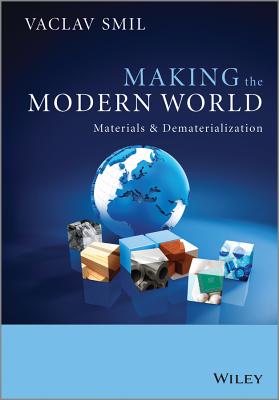Making the Modern World: Materials and Dematerialization
Vaclav Smil

This book gave support to my general approach of not giving up on books. The first half or so is extremely tedious, discussing in great numerical detail world output and consumption of a full range of materials: concrete, wood, steel, plastics, zinc, etc etc etc. I usually read during my commute, and it was often pretty difficult not to fall asleep on the evening commute home while reading the book.
However, the second half was much more interesting. The author discusses trends in “dematerialization” from a variety of perspectives. Are we on a path toward using less material throughput, or less per person, or less per dollar of GDP, etc? This is a surprisingly nuanced topic, and a number of things stuck in my mind. The big take-away is that while there has been some relative dematerialization (say, per dollar of GDP), it is nowhere near enough to reduce the absolute quantity of materials consumed, and won’t be any time in the foreseeable future. (On the other hand, the author is generally fairly sanguine about the ongoing availability of resources.)
One interesting piece was the discussion of recycling. The author emphasized that centralization and recycling efficiency go hand-in-hand. The most efficient recycling happens, for example, on the floor of a steel plant, where shavings can be immediately re-circled through the process. At the other end of the spectrum, recycling of household wastes is not very cost-effective, because of the amount of effort that it takes to get things collected, sorted, and sent where they need to be. In this respect at least, “small is beautiful” doesn’t really hold from an environmental perspective. (Another interesting tidbit was that the Japanese system of paper recycling is so complete and effective that it is very close to the theoretical maximum.)
A second interesting item was on the relative material-intensity of various economies. It is very easy, especially for a left-wing person, to read the relative numbers as a morality play, with low-intensity Japan and Europe as the heroes and high-intensity North America and China as the villains. But Smil takes pains to outline the ways in which such comparisons can be misleading. In general, it has much more to do with supply than with demand. For example, Canada has a relatively materials-intensive economy, but this is largely due to the fact that it has abundant hydroelectric power. This is about the cheapest form of power, so many energy-hungry industries–which also happen to be materials-intensive industries–end up locating there.
A final interesting item was the role of so-called laws, or more like empirical regularities, of materials usage. The big takeaway for me was the extent to which these things are “true until they’re not.” The most familiar one is Moore’s Law, which addresses the rate of increase of the density of transistors on a computer chip. But another one discussed in the book has to do with the relative de-carbonization of fuel. Fuel generally consists of hydrocarbons, i.e. molecules including the elements C and H. As we know, the release of C from combustion is bad for the environment. Over time, there has been a trend toward more H-rich hydrocarbons, which generally burn cleaner–away from wood and coal, toward crude oil, toward natural gas. For decades, this regularity had appeared so clearly that in 1985 someone wrote a book prognosticating about the future of fuels, arguing that by around now, we would be completely on natural gas, and by later in the century, we would be on a pure hydrogen economy (I guess using pure H2 synthesized by electrolysis using renewables). As it turned out, the trend just broke away from its historical line, and while we are still trending toward a higher H:C ratio, it’s just not as fast as the historical pattern.
The last thing I’ll say is that I think the author missed a huge opportunity with this book. As I said, the first half or so is quite dry and boring. But I think it could have been really cool if it were almost all graphs, with just a little explanatory text. This would have gotten the information across in a much clearer and more easily absorbed way, than the pages of text citing figures. I was so surprised by the lack of graphs that I double-checked the “look inside” feature on Amazon for the paper version (I read it as an e-book), but it looks like the physical book doesn’t have graphs either.